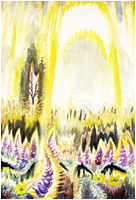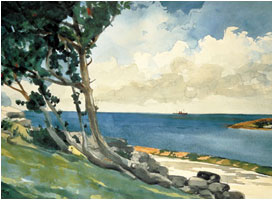 |
| Home | Articles | American Watercolors at the Pennsylvania Academy |
|
|
|
 merican watercolors at the Pennsylvania Academy of the Fine Arts, on view in Philadelphia from October 14, 2000 through January 7, 2001, brings together for the first time in the Museum’s history the highlights of 125 years of watercolor collecting. Drawn primarily from the Academy’s permanent holdings, and also from select Philadelphia-area private collections, this major exhibition of rarely displayed objects features more than 150 works by nearly as many artists, spanning more than two centuries, from the neoclassicism of Benjamin West to the abstraction of Sam Gilliam. merican watercolors at the Pennsylvania Academy of the Fine Arts, on view in Philadelphia from October 14, 2000 through January 7, 2001, brings together for the first time in the Museum’s history the highlights of 125 years of watercolor collecting. Drawn primarily from the Academy’s permanent holdings, and also from select Philadelphia-area private collections, this major exhibition of rarely displayed objects features more than 150 works by nearly as many artists, spanning more than two centuries, from the neoclassicism of Benjamin West to the abstraction of Sam Gilliam.
|
 |
|
Benjamin West (1738-1820), “Portrait of Prince Octavious,” 1783. Gouache over black chalk on buff laid paper. 23 5/16 x 16 5/8" (59.21 x 42.23 cm). Pennsylvania Academy of the Fine Arts, Philadelphia. Gift of Mrs. John Wintersteen, 1983.16
|
The exhibition’s institutional and regional emphasis provides a special opportunity to explore the Academy’s key role in the cultivation of watercolor painting in Philadelphia and the United States. Theodore E. Stebbins, Jr., an historian of American art and watercolor specialist, considers the Academy to be among the great historical proponents of the medium in this country, along with the Metropolitan Museum of Art, the Museum of Fine Arts, Boston, and the Corcoran Galley of Art.1 Watercolor had been a part, albeit a small one, of the Academy’s School programs and its annual exhibitions as early as 1811, after which the first water colors entered the collection. As noted by Kathleen Foster, the contributing author to the exhibition’s accompanying catalogue, serious interest in the medium began to blossom by 1850, approximately sixteen years before the founding of the American Watercolor Society in New York. The growing demand for watercolor exhibitions in the Philadelphia area led, in 1904, to the establishment of a major annual exhibition at the Academy, the Philadelphia Water Color Exhibition, which was devoted specifically to this medium and other graphic works.
|
 |
 |
|
|
| Charles Demuth (1883-1935), “Gladiolas,” ca. 1923-25. Watercolor and graphite on white wove watercolor paper. 18 1/8 x 12" (46.04 x 30.48 cm). Pennsylvania Academy of the Fine Arts, Philadelphia. Gift of John F. Lewis, Jr., 1955.7 |
During the last quarter of the nineteenth century, the Academy began acquiring watercolors in earnest for its permanent collection, mainly through gifts.
Long viewed as the province of artists and connoisseurs with specialized tastes, it was only in the late nineteenth century that watercolors began to win respect among a broader public. In 1886 Frank Mark Etting donated a cache of late eighteenth- and early nineteenth-century watercolor miniatures, which represent some of the earliest examples of watercolor painting in the Academy’s holdings. The oldest work in the collection is a magnificent portrait by Benjamin West, given in 1983 by the celebrated Philadelphia philanthropist Mrs. John Wintersteen.
|
 |
|
Charles E. Burchfield (1893-1967), “Purple Vetch and Buttercups,” 1959.
Watercolor over charcoal on white wove paper. 39 13/16 x 29 13/16" (101.12 x 75.72 cm). Pennsylvania Academy of the Fine Arts, Philadelphia. John Lambert Fund, 1961.1
|
Many private collectors, foundations, artists, their heirs and descendants have contributed regularly to the Academy’s growing treasure trove of watercolors from every period in American art in virtually every style. Many artists are represented by a single work, but a number have been collected in depth, including James Peale, William Trost Richards, Thomas Anshutz, Charles Lewis Fussell, Violet Oakley, Arthur Dove, Charles Demuth, and Robert Motherwell. And the collection continues to grow. Harold A. and Ann R. Sorgenti’s recently promised gift of more than fifty works by contemporary African American artists, which will be the largest contribution to the Academy’s collection in recent history, includes six watercolors and gouaches by such outstanding artists as Willie Birch, Jacob Lawrence, and Raymond Saunders.
It is especially significant that the Academy has scheduled this exhibition for the year 2000, when the Philadelphia Water Color Club celebrates its centennial. Founded in 1900, the Philadelphia Water Color Club co-sponsored the annual Philadelphia Water Color Exhibition at the Academy from its inception in 1904 until 1969, when the Academy ceased all of its annual exhibitions.
These juried showcases, from which the Museum purchased many of the treasures in its graphics collection, were among the most prestigious of their kind in the United States and regularly featured renowned practitioners of the medium, including William Trost Richards, Thomas Eakins, Winslow Homer, John Singer Sargent, Cecilia Beaux, Maurice Prendergast, Arthur Dove, John Marin, Charles Demuth, Edward Hopper, Charles Burchfield, and Andrew Wyeth. Works by all of these artists are featured in this exhibition and the accompanying catalogue. Indeed, more than an opportunity to showcase these prized aspects of the Museum’s holdings, this is an occasion to celebrate the Philadelphia Water Color Club’s historical partnership with the Academy, which led to many important acquisitions.
 |
|
|
Winslow Homer (1836-1910), “North Road, Bermuda,” 1900, Watercolor and pencil on white wove paper. 13 15/16 x 21" (35.40 x 53.34 cm).
Pennsylvania Academy of the Fine Arts, Philadelphia. Partial Gift and Bequest of Mrs. John Wintersteen, 1978.19 |
During the past decade, special exhibitions of watercolors from the collections of the Metropolitan Museum of Art (1991), the Museum of Fine Arts, Boston (1993), the Brooklyn Museum of Art (1998), and the Munson-Williams-Proctor Institute Museum of Art (2000), among others, have demonstrated the special appeal and significance of the medium for scholars and the general public. With this exhibition, the Pennsylvania Academy adds its name to this distinguished roster. Many of the works in the collection are by familiar artists; many others, visitors will find, are not. As a whole, however, the collection is a testament to the foresight of past curators and directors who had the wisdom to collect works of high quality, widely and in depth. Instructors and students in the Academy’s School have been studying this outstanding yet underrecognized resource since its inception. It is with great pleasure that we now provide the general public with its first major opportunity to explore
and enjoy these riches.
1 Theodore E. Stebbins, Jr., American Master Dreawings And
Watercolors: A History Of Works On Paper From Colonial Times To The Present (New York: Harper & Row, 1976), xiv.
|
|
|